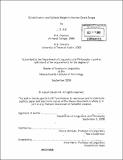Syllabification and syllable weight in Ancient Greek songs
Author(s)
Hill, J. D. (Joseph David)
DownloadFull printable version (10.67Mb)
Other Contributors
Massachusetts Institute of Technology. Dept. of Linguistics and Philosophy.
Advisor
Donca Steriade.
Terms of use
Metadata
Show full item recordAbstract
This thesis is about phonetic events, phonetic representations, and the grammatical constraints on those representations, with respect to one particular phonetic dimension: time. It focuses on a process called beat mapping, whose clearest manifestation is in singing (as opposed to "ordinary" speech). This is the mapping of a sequence of syllables/segments onto a sequence of timing units or beats. The empirical ground is provided by Ancient Greek musical scores. We analyze the way that sensitivity to syllable weight manifests itself in beat mapping. In Ancient Greek, the musical quantity of syllables (their duration, counted in beats) is tightly controlled by their type. Taking this as a robust example of a weight-sensitive process, we set out to demonstrate that syllable weight is not about syllables, but about segments; this is contrary to what current theories of syllable weight assume (see Gordon 2004). We attempt to derive both syllable weight and syllable constituency itself from constraints on the beat mapping of segments. This beat mapping grammar is developed within the general framework of Generalized Correspondence Theory (McCarthy and Prince 2005), and exploits certain properties of correspondence relations, notably non-linearity and reciprocity (bidirectionality). The mapping of segments onto beats respects their linear order but does not reflect them: it is a many-to-many mapping. Correspondence also provides the basis for a new definition of "syllable," which rests on two things: the reciprocity of correspondence relations, and a principle of "salience matching" in mappings between non-homologous domains.
Description
Thesis (S.M.)--Massachusetts Institute of Technology, Dept. of Linguistics and Philosophy, 2008. Includes bibliographical references (p. 89-91).
Date issued
2008Department
Massachusetts Institute of Technology. Department of Linguistics and PhilosophyPublisher
Massachusetts Institute of Technology
Keywords
Linguistics and Philosophy.